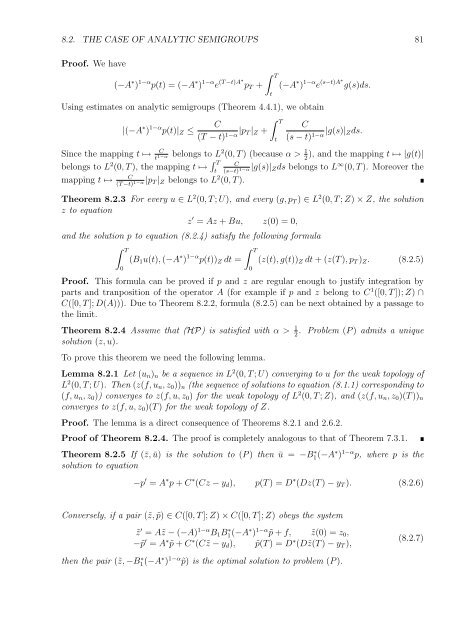Optimal Control of Partial Differential Equations
Optimal Control of Partial Differential Equations
Optimal Control of Partial Differential Equations
Create successful ePaper yourself
Turn your PDF publications into a flip-book with our unique Google optimized e-Paper software.
8.2. THE CASE OF ANALYTIC SEMIGROUPS 81<br />
Pro<strong>of</strong>. We have<br />
(−A ∗ ) 1−α p(t) = (−A ∗ ) 1−α (T −t)A∗<br />
e pT +<br />
Using estimates on analytic semigroups (Theorem 4.4.1), we obtain<br />
|(−A ∗ ) 1−α p(t)|Z ≤<br />
C<br />
(T − t) 1−α |pT |Z +<br />
T<br />
t<br />
T<br />
t<br />
(−A ∗ ) 1−α e (s−t)A∗<br />
g(s)ds.<br />
C<br />
|g(s)|Zds.<br />
(s − t) 1−α<br />
Since the mapping t ↦→ C<br />
t1−α belongs to L2 (0, T ) (because α > 1),<br />
and the mapping t ↦→ |g(t)|<br />
2<br />
belongs to L2 (0, T ), the mapping t ↦→ T C<br />
t (s−t) 1−α |g(s)|Zds belongs to L∞ (0, T ). Moreover the<br />
mapping t ↦→ C<br />
(T −t) 1−α |pT |Z belongs to L2 (0, T ).<br />
Theorem 8.2.3 For every u ∈ L 2 (0, T ; U), and every (g, pT ) ∈ L 2 (0, T ; Z) × Z, the solution<br />
z to equation<br />
z ′ = Az + Bu, z(0) = 0,<br />
and the solution p to equation (8.2.4) satisfy the following formula<br />
T<br />
(B1u(t), (−A<br />
0<br />
∗ ) 1−α T<br />
p(t))Z dt =<br />
0<br />
(z(t), g(t))Z dt + (z(T ), pT )Z. (8.2.5)<br />
Pro<strong>of</strong>. This formula can be proved if p and z are regular enough to justify integration by<br />
parts and tranposition <strong>of</strong> the operator A (for example if p and z belong to C 1 ([0, T ]); Z) ∩<br />
C([0, T ]; D(A))). Due to Theorem 8.2.2, formula (8.2.5) can be next obtained by a passage to<br />
the limit.<br />
Theorem 8.2.4 Assume that (HP) is satisfied with α > 1.<br />
Problem (P ) admits a unique<br />
2<br />
solution (z, u).<br />
To prove this theorem we need the following lemma.<br />
Lemma 8.2.1 Let (un)n be a sequence in L 2 (0, T ; U) converging to u for the weak topology <strong>of</strong><br />
L 2 (0, T ; U). Then (z(f, un, z0))n (the sequence <strong>of</strong> solutions to equation (8.1.1) corresponding to<br />
(f, un, z0)) converges to z(f, u, z0) for the weak topology <strong>of</strong> L 2 (0, T ; Z), and (z(f, un, z0)(T ))n<br />
converges to z(f, u, z0)(T ) for the weak topology <strong>of</strong> Z.<br />
Pro<strong>of</strong>. The lemma is a direct consequence <strong>of</strong> Theorems 8.2.1 and 2.6.2.<br />
Pro<strong>of</strong> <strong>of</strong> Theorem 8.2.4. The pro<strong>of</strong> is completely analogous to that <strong>of</strong> Theorem 7.3.1.<br />
Theorem 8.2.5 If (¯z, ū) is the solution to (P ) then ū = −B ∗ 1(−A ∗ ) 1−α p, where p is the<br />
solution to equation<br />
−p ′ = A ∗ p + C ∗ (Cz − yd), p(T ) = D ∗ (Dz(T ) − yT ). (8.2.6)<br />
Conversely, if a pair (˜z, ˜p) ∈ C([0, T ]; Z) × C([0, T ]; Z) obeys the system<br />
˜z ′ = A˜z − (−A) 1−α B1B ∗ 1(−A ∗ ) 1−α ˜p + f, ˜z(0) = z0,<br />
−˜p ′ = A ∗ ˜p + C ∗ (C ˜z − yd), ˜p(T ) = D ∗ (D˜z(T ) − yT ),<br />
then the pair (˜z, −B ∗ 1(−A ∗ ) 1−α ˜p) is the optimal solution to problem (P ).<br />
(8.2.7)

















